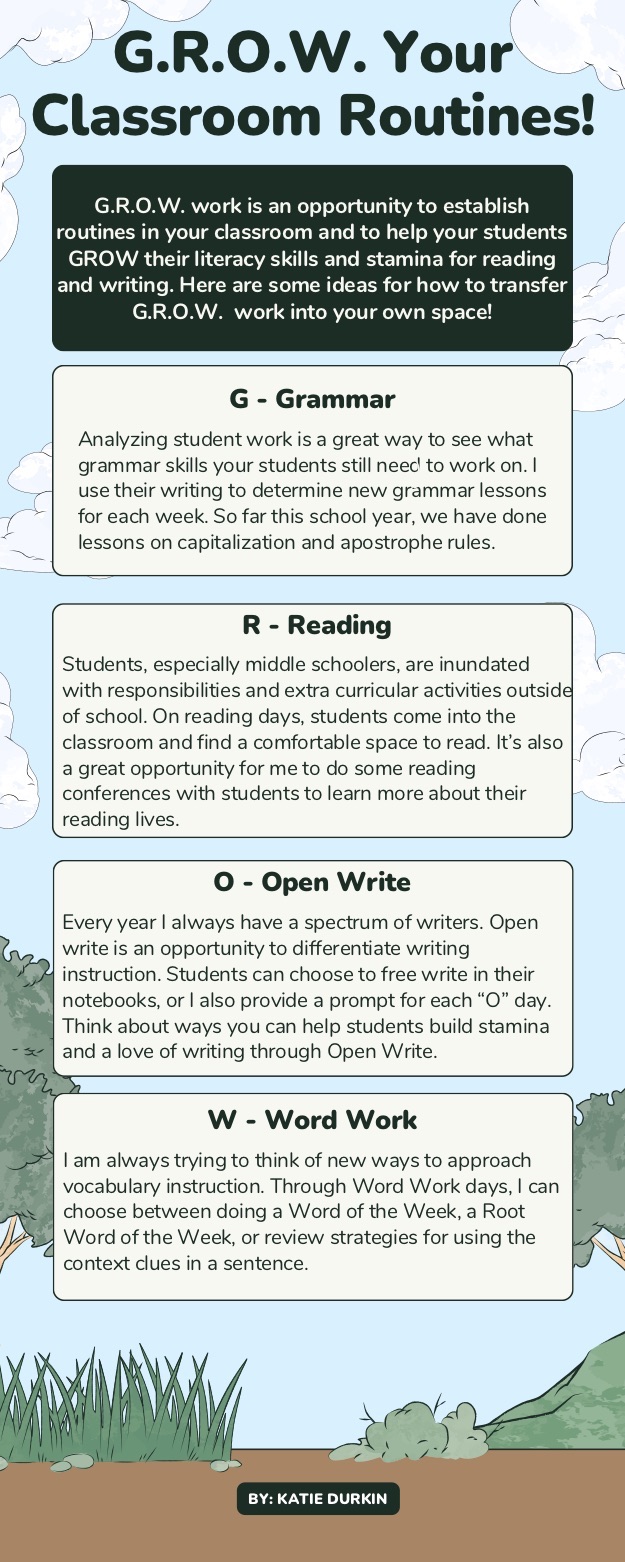Routines Can Help Grow Student Literacy Skills
By Katie Durkin
 Coming into this new school year, I was prepared for a lot of changes. My school was changing to a new schedule with new teams and new curriculum. The new curriculum would mean that reading and writing would be taught together in one course when it had been previously taught by two different teachers.
Coming into this new school year, I was prepared for a lot of changes. My school was changing to a new schedule with new teams and new curriculum. The new curriculum would mean that reading and writing would be taught together in one course when it had been previously taught by two different teachers.
We also would have longer 60-minute classes. With this integration of curricula and the extended periods, I thought it was a perfect opportunity to establish some new routines for students to grow their literacy skills.
This year my students began with a regular weekly routine of G.R.O.W. lessons (Grammar, Reading, Open Write, and Word Work). For the grammar, writing, and vocabulary lessons, they are completing work in composition books. All the lessons I’ll teach will help students to ‘grow’ their literacy skills – skills they can apply not only in my class but across the academic disciplines.
In this article, I’ll explain the four-day G.R.O.W. rotation I’ve established, the work students do in their notebooks, and how you might transfer this work into your own learning space.
[G] Middle school kids need lots of grammar help
I’m never surprised to learn my new middle school students need help with grammar. There are some lessons I can anticipate teaching every year. For example, I know that in the era of texting and social media many middle school students struggle with figuring out what to capitalize and need to review capitalization rules, so that’s where we began.
Grammar lessons are designed based on the students’ needs. I don’t want to teach them grammar concepts unless I see a need in their writing. So far, I have done lessons on spelling, using apostrophes appropriately, and the difference between there, their, and they’re.
I analyze students’ writing for patterns and determine which grammar lessons are needed right away. I created a mini anchor chart to paste or tape into their notebooks so they can refer back to some key grammar rules. We also do some short writing activities where students can practice what they’re learning.
In addition, I ask them to write a response explaining why capitalization or spelling or apostrophes are important. I want my students to think about why we should apply grammar rules in writing, and their notebooks can remind them throughout the year about the importance of the grammar rules we review together.
What I’ve enjoyed most about tying these lessons to a dedicated composition book is being able to refer back to the books when I notice students are making the same mistakes. Grammar lessons will evolve throughout the year as I continue to read and use student work to guide my planning.
Take away: Think about examining your students’ work for common grammar mistakes and design lessons to help them understand the importance of proper grammar. Creating mini anchor charts and having students put them in a notebook is a great way for students to have the grammar tips on hand whenever they write.
[R] Regular reading just for fun
The second day in our four-day rotation is set aside for reading books for fun. Because middle school students often have hectic schedules after school, having time to read during school is incredibly important. On reading days, I ask them to come into our classroom and find a comfortable place to read for about 15-20 minutes.
This also gives me time to check in with students’ reading preferences through one-on-one conferences. Each reading day I will try to conference with 4-5 students, asking them about their current book, what they’re enjoying, and what they plan to read next. My hope is that by providing them this time they will become invested in their books and plan to set aside time to read at home. And the conferencing gives me a chance to see what they like to read the most so I can curate books for our class library and plan for future units.
Take away: Think about ways you can set up time in your classroom for students to regularly read. It will help establish reading habits and routines and give you a chance to learn more about their reading lives.
[O] Regular writing builds skills and stamina
On “O” days, students have the option to open write or respond to a prompt related to our current unit in their composition books. Middle school students often need help building their stamina for writing. At a minimum, I ask them to try and fill as much of a page as they can.
Much like regular reading time, when students are given the first 15 minutes of class to just practice their writing in school, they will build their stamina and skills. They can also practice different writing genres and styles.
What I’ve loved most about these days is it allows me to differentiate for students who have different writing needs. Because it is ‘open write,’ students have a choice.
Some students who are passionate about poetry have the opportunity to write poems. Some who are amazing artists have been creating comic book strips. Others have been continuing “passion” writing projects they started last year; for example, some students are collaboratively writing fantasy stories. By also providing an optional prompt, I can ensure that everyone will have an opportunity to write about something during our open write days.
Take away: Consider ways that you can establish routines in your classroom that give students a chance to write regularly about what interests them. Challenge them to fill the page(s), explore different writing forms, and apply some of the grammar rules you’re studying.
[W] Word work expands vocabulary
The final day in our G.R.O.W. work rotation is for word work. This is an opportunity to introduce students to challenging words that they will most likely come across in their fiction and academic reading.

All of this word work is kept in their composition books. Similar to our grammar lessons, the vocabulary lessons they complete become a resource they can use in their writing. Students have been having a lot of fun with the words we have done so far. I have even asked the teachers on our team to use the words in their instruction or conversation with students so they’re exposed to the vocabulary as much as possible.
Now that students have done a couple weeks with my words, I’ve asked them to start collecting words from their own reading in the back of their composition books, and we will start using their words for word of the week. I believe this gives students more autonomy over their learning and shows I value what words they’re noticing in their reading.
Take away: Envision ways that you can change your vocabulary instruction this year to include word work, or word of the week, and more importantly, think about how you can use student voice and choice in this work.
Molding lessons to fit my students’ needs
With all of this work, I let students be my guide. Their work, their work ethic, and their attitudes towards reading and writing help to guide how I design my G.R.O.W. lessons. I don’t want any of their G.R.O.W. skills to be disconnected to what we’re already doing in the classroom and what they will need for literacy skills later in life, so I’m always looking for ways to integrate the learning (like using their new words in their open writing work or in writing for other teachers).
So far, I’ve been impressed by what my students have been able to learn and apply to both my classroom and other academic subjects. It’s also been great to set up a set of routines that have my students ready to jump into our work every day without direction from me. They’re excited by the grammar, reading, writing, and vocabulary work we are doing, and I’m excited to see how our G.R.O.W. routines will continue to evolve this year.
Dr. Katie Durkin (@kmerz610) has been teaching middle school students for over a decade, and currently teaches English Language Arts at public Middlebrook School in Wilton, Connecticut, where she is the 7th Grade Team Leader.
Katie is a zealous reader of middle grade and young adult books and enjoys sharing her love and passion for reading with her students. In 2022 she earned her doctorate from Northeastern University, where her dissertation research examined the impact of classroom libraries on middle school students’ reading engagement.
Katie was the 2020 recipient of the Edwyna Wheadon Postgraduate Training Scholarship from the NCTE. She writes regularly for MiddleWeb and in early 2023 launched a podcast, That’s Novel Reading.





































Terrific approach and recognition of the need for better LITERACY skills.